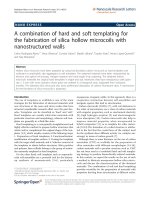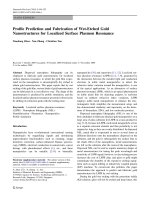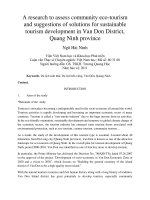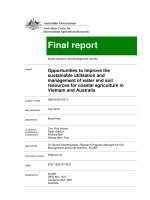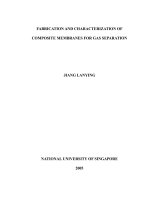Fabrication of nanofiltration hollow fiber membranes for sustainable pharmaceutical manufacture
Bạn đang xem bản rút gọn của tài liệu. Xem và tải ngay bản đầy đủ của tài liệu tại đây (3.28 MB, 158 trang )
FABRICATION OF NANOFILTRATION HOLLOW
FIBER MEMBRANES FOR SUSTAINABLE
PHARMACEUTICAL MANUFACTURE
SUN SHIPENG
(B. Eng., Tianjin University)
A THESIS SUBMITTED
FOR THE DEGREE OF DOCTOR OF PHYLOSOPHY
IN CHEMICAL AND PHARMACEUTICAL ENGINEERING
SINGAPORE-MIT ALLIANCE
NATIONAL UNIVERSITY OF SINGAPORE
2011
i
ACKNOWLEDGEMENT
First of all, I would like to express my deepest appreciation to my supervisor Prof.
Chung Tai-Shung, in the Department of Chemical and Biomolecular Engineering at
National University of Singapore (NUS), for his valuable direction, enthusiastic
encouragement and invaluable support throughout my PhD study. I am also indebted
to my supervisor, Prof. T. Alan Hatton, in the Department of Chemical Engineering at
Massachusetts Institute of Technology (MIT), for his unselfishness and
knowledgeable guidance, suggestions and patient help on my research work. They not
only provide essential laboratory facilities for my research study but also enlighten e
on the understanding, thinking and exploring in the academic area.
I would also like to thank my thesis committee members, Prof. Saif A. Khan and Prof.
Jiang Jianwen at NUS, and Prof. Bernhardt L. Trout at MIT for their constructive
advice and instruction. I also want to acknowledge Singapore-MIT Alliance for
providing me PhD scholarships through the past four years.
I also wish to take this opportunity to give my sincere thanks to all the colleagues in
our research group for their kind assistance. Special thanks are due to Dr. Wang
Kaiyu, Dr. Teoh Maymay, Dr. Yang Qian, Dr. Natalia Widjojo and Dr. Wang Yan for
their assistance and generous suggestions.
Last but not least, I am most grateful to my parents, Mr. Sun Yunsheng and Ms. Dong
Wen, and my wife Ms. Li Xin, for their endless love, encouragement and support that
enable me to continue my academic career.
ii
TABLE OF CONTENTS
ACKNOWLEDGEMENT i
TABLE OF CONTENTS ii
SUMMARY vii
LIST OF TABLES x
LIST OF FIGURES xii
LIST OF SYMBOLS xvi
CHAPTER 1: Introduction 1
1.1 Membrane Technology 1
1.2 Nanofiltration 2
1.3 Applications of nanofiltration membranes 3
1.3.1 General applications 3
1.3.2 NF membranes for sustainable pharmaceutical manufacture 4
1.4 Fabrication of NF membranes 6
1.5 Module types for NF membrane fabrication 7
1.6 Materials for NF fabrication: Torlon® polyamide-imide 8
1.7 Theoretical background for NF membrane characterization 9
1.7.1 Performance parameters 9
1.7.2 Determination of mean effective pore size, pore size distribution and
molecular weight cutoff (MWCO) 10
1.7.3 Determination of reflection coefficient, σ, the solute permeability P and
effective charge density,
X 11
1.8 Research objectives and thesis organization 13
iii
CHAPTER 2: FABRICATION OF POLYAMIDE-IMIDE NANOFILTRATION
HOLLOW FIBER MEMBRANES WITH ELONGATION-INDUCED
NANO-PORE EVOLUTION 16
2.1 Introduction 16
2.2 Experimental 18
2.2.1 Materials 18
2.2.2 Preparation of Torlon® PAI NF hollow fiber membranes 18
2.2.3 Characterizations 20
2.2.4 Nanofiltration experiments with Torlon® PAI NF hollow fiber membranes
22
2.3 Results and discussion 24
2.3.1 Effects of take-up speed on membrane morphology, elongational draw ratio
and porosity 24
2.3.2 Effects of take-up speed on mean pore size, pore size distribution and pure
water permeability 25
2.4 Conclusions 33
CHAPTER 3: CHARACTERIZATION OF CHARGE PROPERTIES OF
POLYAMIDE-IMIDE NANOFILTRATION HOLLOW FIBER
MEMBRANES AND REJECTION OF GLUTATHIONE 35
3.1 Introduction 35
3.2 Experimental 36
3.2.1 Materials 36
3.2.2 Zeta-potential measurements 36
3.2.3 Nanofiltration experiments of salt and glutathione with PAI NF hollow
fiber membranes 37
3.3 Results and discussion 38
3.3.1 Membrane characterization using single electrolyte solutions 38
3.3.2 Ion fractionation by PAI NF membranes in the electrolyte mixture solutions
42
3.3.3 Rejection of glutathione by PAI NF hollow fiber membranes 43
iv
3.4 Conclusions 45
CHAPTER 4: FABRICATION OF POLYAMIDE-IMIDE/CELLULOSE ACETATE
DUAL-LAYER HOLLOW FIBER MEMBRANES FOR
NANOFILTRATION 46
4.1 Introduction 46
4.2 Experimental 49
4.2.1 Materials 49
4.2.2 Preparation and characterization of polymer dope solutions 49
4.2.3 Fabrication of PAI/CA NF dual-layer hollow fiber membranes 52
4.2.4 Characterization of PAI/CA NF dual-layer hollow fiber membranes 53
4.3 Results and discussion 56
4.3.1 Effects of non-solvent additives on the overall morphology 56
4.3.2 Effects of non-solvent additives on NF performance 61
4.3.3 Effects of spinneret temperature on NF performance 68
4.4 Conclusions 72
CHAPTER 5: HYPERBRANCHED POLYETHYLENEIMINE INDUCED CROSS-
LINKING OF POLYAMIDE-IMIDE NANOFILTRATION HOLLOW
FIBER MEMBRANES FOR EFFECTIVE REMOVAL OF
CIPROFLOXACIN 74
5.1 Introduction 74
5.2 Experimental 76
5.2.1 Materials 76
5.2.2 Preparation of PAI hollow fiber membrane support 77
5.2.3 Chemical modification 78
5.2.4 Characterizations 79
5.3 Results and discussion 84
5.3.1 Morphology of PAI hollow fiber membranes 84
v
5.3.2 Characterization of modified PAI hollow fiber membranes 85
5.3.3 Nanofiltration performance of PEI modified membranes 90
5.4 Conclusions 99
CHAPTER 6: FABRICATION OF THIN-FILM COMPOSITE NANOFILTRATION
HOLLOW FIBER MEMBRANE VIA INTERFACIAL
POLYMERIZATION FOR EFFECTIVE REMOVAL OF
EMERGING ORGANIC MATTERS FROM WATER 100
6.1 Introduction 100
6.2 Experimental 102
6.2.1 Materials 102
6.2.2 Fabrication of dual-layer PAI hollow fiber membrane support 103
6.2.3 Interfacial polymerization 105
6.2.4 Characterizations 106
6.2.5 Nanofiltration experiments 106
6.2.6 Chemical analyses 108
6.3 Results and discussion 108
6.3.1 Morphology of the PAI dual-layer hollow fiber membrane support 108
6.3.2 Effects of molecular weight and concentration of PEI on NF performance
110
6.3.3 Characterizations of the interfacial polymerized NF membranes 111
6.3.4 Effects of interfacial polymerization on pure water permeability, pore size,
pore size distribution and molecular weight cutoff 112
6.3.5 Rejections of salt solutions by the PAI NF dual-layer hollow fiber
membranes 115
6.3.6 Rejections of dye solutions by the PAI NF dual-layer hollow fiber
membranes 116
6.3.7 Rejection of cephalexin by the PAI NF dual-layer hollow fiber membranes
120
6.4 Conclusions 122
vi
CHAPTER 7: CONCLUSIONS AND RECOMMENDATIONS 124
7.1 Conclusions 124
7.2 Recommendations 127
BIBLIOGRAPHY 129
APPENDICES: Publications and conferences 140
vii
SUMMARY
The molecular design of nanoporous membranes with desired morphology and
selectivity has attracted significant interests over the past decades. A major problem
in their applications is the trade-off between sieving property and permeability. A
novel elongation-induced nano-pore evolution was discovered. The method can
synergistically decrease the pore size and increase the pure water permeability of a
novel Torlon
®
polyamide-imide (PAI) nanofiltration (NF) hollow fiber membrane
with the aid of external stretching in a dry-jet wet-spinning process. The molecular
weight cutoff (MWCO) and pore size distribution of the membranes were finely tuned
by this approach.
Zeta-potential and salt rejection tests verify that the PAI NF membrane has an
isoelectric point at about 3.2, above which the membrane is negatively charged. As a
result, the resultant PAI NF membranes exhibit highly effective fractionation of the
divalent and monovalent ions of NaCl/Na
2
SO
4
salt solutions. Furthermore, more than
99.5% glutathione can be rejected by the PAI NF membranes at neutral pH, offering
the feasibility to recover this tripeptide.
A dual-layer NF hollow fiber membrane was fabricated by the simultaneous co-
extrusion of polyamide-imide and cellulose acetate dopes through a triple-orifice
spinneret in a dry-jet wet phase inversion process. The nanopores of dual-layer hollow
fiber membranes were molecularly designed by controlling the phase inversion
process with the aid of various non-solvent additives into the polymer solutions.
viii
Compared to ethanol and 2-propanol, the addition of methanol into the dope led to a
significantly decreased pore size but dramatically increased pure water permeability.
The improved NF performance may be attributed to (1) a controllable thin selective
outer layer; (2) a less resistant interface between the outer and inner layers; and (3) a
fully porous substructure with reduced transport resistance.
A positively charged NF membrane was fabricated by hyperbranched
polyethyleneimine (PEI) induced cross-linking on a PAI hollow fiber. It is found that
after PEI induced cross-linking, the membrane pore size is significantly reduced. The
membrane surface becomes more hydrophilic and positively charged. As a result of
these synergic effects, the rejection of ciprofloxacin is substantially enhanced. The NF
membrane modified by a high molecular weight PEI_60K exhibits the highest
rejection, the lowest fouling tendency and keeps a constant flux over the whole pH
range.
A thin-film composite NF membrane was fabricated by interfacial polymerization of
hyperbranched polyethyleneimine and isophthaloyl chloride. After interfacial
polymerization, the NF membrane possesses a negatively charged substrate and a
positively charged selective layer with a mean pore radius of 0.36 nm, MWCO of 489
Da, and pure water permeability of 4.85 lm
-2
bar
-1
h
-1
. Due to this double-repulsion
effect, together with the steric-hindrance and the solute electro-neutrality effects, the
newly developed NF membrane shows superior rejections (over 99%) for both
positively and negatively charged dye molecules. By adjusting the pH of cephalexin
aqueous solution to modify the ionization states of this zwitterionic molecule, the NF
membrane shows high rejections over a wide pH range. The NF membrane may
ix
potentially be useful to reduce waste, recycle valuable products and reuse water for
pharmaceutical, textile and other industries.
x
LIST OF TABLES
Table 1.1 Pressure driven processes and characteristics 2
Table 1.2 General overview of NF applications 4
Table 1.3 Comparison of different module types 8
Table 2.1 Diffusivities and Stokes radii of neutral solutes in aqueous solutions (at
25ºC) 18
Table 2.2 Spinning conditions of Torlon
®
PAI NF hollow fiber membranes 19
Table 2.3 Molecular weight cut off (MWCO), mean effective pore size (r
p
),
geometric standard deviation (
p
) and Pure water permeability (PWP) of
Torlon
®
PAI NF hollow-fiber membranes spun at different take-up speeds
27
Table 2.4 Effects of take-up speed on roughness and nodule size of the outer surface
of Torlon
®
PAI NF hollow fiber membranes 32
Table 3.1 Reflection coefficient and Permeability of various concentrations of NaCl
determined from the Spiegler–Kedem equations 40
Table 4.1 The dope compositions of PAI/CA dual-layer hollow fiber membranes 51
Table 4.2 Spinning conditions of the dual layer hollow fiber membranes 53
Table 4.3 Mean effective pore radius (r
p
), geometric standard deviation (
p
),
molecular weight cut off (MWCO), and pure water permeability (PWP) of
dual-layer NF hollow fiber membranes spun with different non-solvent
additives 63
Table 4.4 Properties of solvent and non-solvents 64
Table 4.5 Mean effective pore radius (r
p
), geometric standard deviation (
p
),
molecular weight cut off (MWCO), and pure water permeability (PWP) of
dual-layer NF hollow fiber membranes spun at different spinneret
temperature 70
Table 5.1 Spinning conditions of Torlon® PAI NF hollow fiber membranes 78
Table 5.2 XPS Analysis of the original and PEI modified NF hollow fiber membranes.
87
Table 5.3 Contact angle, isoelectric point, zeta-potential, and adsorption capacity of
the original and PEI modified NF hollow fiber membranes 88
xi
Table 5.4 Mean effective pore radius (r
p
), geometric standard deviation (
p
),
molecular weight cut off (MWCO), and pure water permeability (PWP) of
the original and PEI modified NF hollow fiber membranes 91
Table 6.1 Diffusivities and Stokes radii of neutral solutes in aqueous solutions (at
25ºC) 103
Table 6.2 Spinning conditions of the dual-layer hollow fiber membranes 104
Table 6.3 Effects of molecular weight and concentration of HPEI on pure water
permeability (PWP), rejections of raffinose and MgCl
2
105
Table 6.4 Mean effective pore radius (r
p
), geometric standard deviation (
p
),
molecular weight cut off (MWCO), and pure water permeability (PWP) of
the membrane before and after interfacial polymerization 113
Table 6.5 Structures, molecular dimensions, rejections and fluxes of dye molecules
and saccharose filtrated by the interfacial polymerized membrane. 120
xii
LIST OF FIGURES
Figure 1.1 Application ranges of MF, UF, NF and RO membranes 2
Figure 1.2 Ionization states of glutathione at different pH values 5
Figure 1.3 Chemical structure and ionization groups of ciprofloxacin 6
Figure 1.4 The general structure for Torlon
®
4000T polyamide-imide 8
Figure 2.1 Schematic diagram of a hollow fiber spinning line 19
Figure 2.2 Schematic diagram of the nanofiltration system 23
Figure 2.3 Morphology of Torlon
®
PAI NF hollow fiber membranes 25
Figure 2.4 Effects of take-up speed on the membrane structure of Torlon
®
PAI NF
hollow-fiber membranes 25
Figure 2.5 Effective rejection curves (solute rejections vs. their Stokes radii) for
Torlon
®
PAI NF hollow fibers spun at different take-up speeds 26
Figure 2.6 Cumulative pore size distribution curves of the Torlon
®
PAI NF hollow
fiber membranes spun at different take-up speeds 27
Figure 2.7 Probability density function curves of the Torlon
®
PAI NF hollow-fiber
membranes spun at different take-up speeds 27
Figure 2.8 AFM images of the outer surface of Torlon
®
PAI NF hollow fiber spun at
different take-up speeds. (a) phase image, (b) 3D image 29
Figure 2.9 Phase diagram for a ternary system and the coagulation path during the
precipitation of a Torlon
PAI hollow fiber at a constant temperature 30
Figure 2.10 FESEM images of the near outer layer of Torlon
®
PAI NF hollow fiber
membranes spun at different take-up speeds 31
Figure 2.11 Polarized FTIR spectra of Torlon
®
PAI NF hollow fiber membranes 33
Figure 3.1 Zeta potential of Torlon
®
NF membrane as a function of pH 39
Figure 3.2 Rejections as function of permeate volume flux J
v
with different NaCl
concentrations 40
Figure 3.3 The effective charge density as a function of bulk NaCl molar
concentration 41
Figure 3.4 The rejection of different salts at different pressures 42
xiii
Figure 3.5 Ion rejection of the binary mixture of NaCl/Na
2
SO
4
solution as a function
of NaCl concentration 43
Figure 3.6 Rejection of glutathione (200 ppm) as affected by solution pH by
membrane C with r
p
=0.46nm 44
Figure 4.1 The chemical structures of cellulose acetate (CA-398-30) 48
Figure 4.2 Diagram of the dual-layer spinneret with indented premixing feature 53
Figure 4.3 Effects of non-solvent additives on the delamination of the dual-layer
hollow fiber membranes (Scale bar 50µm) 57
Figure 4.4 Phase diagrams for (a) CA/NMP+nonsolvent/Mg(ClO4)2/Water; (b)
Torlon® 4000TF/NMP+nonsolvent/Water system 58
Figure 4.5 Cross section images of the dual-layer hollow fiber membranes 60
Figure 4.6 FESEM images of the different surfaces of the dual-layer hollow fiber
membranes 61
Figure 4.7 Log-normal probability plots of the effective rejection curves (solute
rejections vs. their Stokes radii) for dual-layer hollow fiber membranes
spun with different non-solvent additives 62
Figure 4.8 (a) Cumulative pore size distribution curves and (b) probability density
function curves for the dual-layer NF hollow-fiber membranes spun with
different non-solvent additives 63
Figure 4.9 Effects of non-solvent additives on the cross section of the dual-layer
hollow fiber membranes 65
Figure 4.10 Effects of non-solvent additives on the surfaces of the dual-layer hollow
fiber membranes. (a) The outer surface of the outer layer; (b) The inner
surface of the outer layer 66
Figure 4.11 Effects of non-solvent additives on the rejections of different single salts
68
Figure 4.12 Log-normal probability plots of the effective rejection curves (solute
rejections vs. their Stokes radii) for dual-layer hollow fiber membranes
spun at different spinneret temperatures 69
Figure 4.13 Effects of spinneret temperature on the rejections of different single salts
69
Figure 4.14 (a) Cumulative pore size distribution curves and (b) probability density
function curves for the dual-layer NF hollow-fiber membranes spun at
different temperature 70
Figure 4.15 Effects of spinneret temperature on the morphology of dual-layer hollow
fiber membranes 71
xiv
Figure 5.1 The chemical structures of hyperbranched polyethyleneimine 77
Figure 5.2 Procedure of PAI hollow fiber membrane cross-linking by
polyethyleneimine 80
Figure 5.3 Morphology of Torlon® PAI NF hollow fiber membranes. 85
Figure 5.4 ATR-FTIR spectra of PAI NF hollow fiber membranes modified by PEI
with various molecular weights 86
Figure 5.5 The possible chemical structure of polyamide-imide cross-linked by
hyperbranched polyethlyeneimine 88
Figure 5.6 Zeta potential vs. pH curves of PAI NF membranes modified by PEI with
various molecular weights. Experiments were carried out with 0.01 M
NaCl 90
Figure 5.7 Effects of PEI modification on rejection of neutral solutes at pH 5.75 91
Figure 5.8 (a) Cumulative pore size distribution curves and (b) probability density
function curves of PAI NF hollow fiber membranes modified by PEI with
various molecular weights. 92
Figure 5.9 Effects of PEI modification on rejection of electrolyte solutions at pH 5.75.
94
Figure 5.10 Effects of PEI modification on rejection of ciprofloxacin solutions as a
function of pH 95
Figure 5.11 Effects of PEI modification on permeate flux of ciprofloxacin solutions
as a function of pH 96
Figure 5.12 (a) Pure water flux as a function of pH at 10 bar and (b) normalized flux,
J/J
0
at various pH 97
Figure 6.1 The chemical structures of (a) Hyperbranched polyethyleneimine, (b)
Isophthaloylchloride 103
Figure 6.2 Morphology of the PAI dual-layer hollow fiber membranes 109
Figure 6.3 (a) FESEM and (b) AFM images of the outer surface before and after
interfacial polymerization 112
Figure 6.4 Rejections of neutral organic solutions by the membranes before and after
interfacial polymerization 113
Figure 6.5 (a) Cumulative pore size distribution and (b) probability density function
of the membranes before and after interfacial polymerization 114
Figure 6.6 The possible chemical structure of the interfacial polymerized network
formed with hyperbranched polyethyleneimine and isophthaloyl chloride
115
xv
Figure 6.7 Salt rejections of the membranes before and after interfacial
polymerization 116
Figure 6.8 Rejection of (a) positively charged dye, Safranin O, and (b) negatively
charged dye, Orange II sodium salt, solutions. The left bottle is the feed
solution while the right bottle is the permeate 118
Figure 6.9 A schematic diagram showing solute transport through interfacial
polymerized NF membranes 120
Figure 6.10 Ionization states of cephalexin at various pH values. 121
Figure 6.11 Cephalexin rejection of the membranes before and after interfacial
polymerization as a function of pH. 122
xvi
LIST OF SYMBOLS
A
effective filtration area of membrane (m
2
)
A
k
/∆x
ratio of membrane porosity over thickness (m
−1
)
C
f
solute concentration in the feed solution (mol m
-3
)
C
m
concentration at the membrane surface (mol m
−3
)
C
p
solute concentration in the permeate (mol m
-3
)
CA cellulose acetate
D
i
diffusivity of ion i in free solution (m
2
s
−1
)
D
s
diffusivity of solute in the solution (m
2
s
-1
)
EG ethylene glycol
J
s
solute or ion flux (molm
−2
s
−1
)
J
v
permeate flux (m
3
m
−2
s
−1
)
MW molecular weight (Da)
MWCO molecular weight cut off (Da)
NMP n-methyl-2-pyrrolidinone
OD
outer diameter (m)
ID
inner diameter (m)
IPC isophthaloyl chloride
P
solute permeability (m s
−1
)
ΔP trans-membrane pressure drop (bar)
PAI polyamide-imide
PEI polyethyleneiminne
pK
a
ionization equilibrium constant (-)
IPA 2-propanol
PSf polysulfone
PWP pure water permeability (liter m
-2
bar
-1
hr
-1
)
Q
water permeate flux (m
3
h
−1
)
r
s
solute Stokes radius (nm)
r
p
effective pore radius (nm)
xvii
R
T
solute rejection (-)
SPES sulfonated polyethersulfone
TFC thin film composite
α
transport number of cations in free solution defined as α =D
1
/(D
1
+D
2
)
ε
overall porosity (-)
p
mean effective pore radius (nm)
s
geometric mean radius of solute at R
T
= 50% (nm)
ξ
ratio of effective volume charge density (
X) of membrane to the
electrolyte concentration (C
m
) at the membrane surface
∆π
osmotic pressure difference (bar)
reflection coefficient (-)
g
geometric standard deviation about
s
, (-)
p
geometric standard deviation about
p
, (-)
X
effective membrane charge (mol m
−3
)
1
CHAPTER ONE
INTRODUCTION
1.1 Membrane technology
In the 21
st
century, the sustainable development of the human society faces three major
problems: water, energy and health. These challenges have prompted the search of new
technologies for more efficient production of clean water and renewable energy and for more
effective protection of human health and the environment [1-3]. In terms of the chemical
industry, many ongoing research thrusts attempt to explore innovative green technologies to
reduce waste, recycle valuable products and reuse water at lower expenditure with less
energy consumption [4, 5]. Membrane technology has gained enormous importance over the
past decades by replacing conventional separation methods or integrating with them. This is
because membrane technology has the advantages including selective permeation, reduced
energy consumption and non-thermal processing of sensitive compounds [5].
The driving force for membrane separations is the difference of chemical potential between
two separated phases. This potential difference can result in pressure difference,
concentration difference, and electrical potential difference or any combination of these
variables [6]. Membrane processes for liquid based separation that utilize pressure difference
as the driving force can be divided in to microfiltration (MF), ultrafiltration (UF),
nanofiltration (NF) and reverse osmosis (RO), as shown in Figure 1.1. Their general
characteristics, including pore size range, separation mechanism, pressure range and flux
range, are listed in Table 1.1. Among these types of membranes, MF membranes have the
2
largest pore size, which is only suitable to reject large particles such as suspended solids. For
UF membranes, macromolecules such as proteins can be rejected while small molecules such
as ions and amino acids can pass through. RO membranes are considered as non-porous or
have pores only allow water to pass through.
Figure 1.1 Application ranges of MF, UF, NF and RO membranes.
Table 1.1 Pressure driven processes and characteristics [6, 7].
MF UF NF RO
Pore size (nm) 50-5000 1-100 0.5-2 <0.5
Separation
mechanism
Size
exclusion
Size
exclusion
Size exclusion and
Donnan exclusion
Solution diffusion
and size exclusion
Pressure (bar) <2 1-5 5-20 10-100
Flux range
(Lm
-2
hr
-1
bar
-1
)
>50 10-50 1.4-12 0.05-1.4
1.2 Nanofiltration
NF membranes received their name because they have a nominal molecular weight cutoff
(MWCO, molecular weight of solute that is 90% rejected by the membrane) ranging from
200 to 1000 Dalton and pore sizes of about 0.5 - 2.0 nm [7, 8]. Unlike the other membrane
types, a unique property of NF membranes is that the separation mechanism involves not
only steric (size exclusion) effect, but also an electrostatic partitioning interaction (Donnan
3
exclusion) between membrane and external solution. As a result, NF membranes can reject
small organic molecules and divalent ions but let monovalent ions to pass through. In
addition, it offers advantages of higher retention than UF and lower pressure requirement
than RO [9]. Therefore, fabrication, characterization and application of NF membranes have
received more and more attentions by researchers from both of academy and industry.
1.3 Applications of nanofiltration membranes
1.3.1 General applications
Since its inception in the early 1970s, nanofiltration (NF) has grown rapidly and become very
important for liquid based separation processes through its unique ability to separate and
fractionate ionic and low molecular weight organic species. In the last few decades, NF has
found extensive applications as a separation and purification technique in not only aqueous
separations such as desalination [1, 10], wastewater treatment [11], pharmaceutical
purification [12, 13] and biomedical applications [14], but also organic solvent based
separations emerging in the chemical [15], petrochemical [16] and other industries. More
specific examples can be found in Table 1.2.
4
Table 1.2 General overview of NF applications.
Industry Application Reference
Water
Water softening [17]
Removal of natural organic matters (NOM) from water [18]
Removal of heavy metals from water [19]
Desalination in forward osmosis (FO) process [10]
Pharmaceutical
Removal of pharmaceutical active compounds [20]
Recovery and concentration of antibiotics [13]
Enantiomer separation [21]
Recover organic solvents with solvent resistant NF membranes [22]
Textile Removal of dye, color, turbidity in waste water [23]
Food Concentration and demineralization of whey [24, 25]
Pulp and paper Treatment of effluents to reuse water [26]
Diverse
Lube dewaxing with solvent resistant NF membranes [27]
Recovery of catalyst with solvent resistant NF membranes [28]
Concentration of proteins through FO process [29]
1.3.2 NF membranes for sustainable pharmaceutical manufacture
Pharmaceuticals have been making significant contributions to the healthcare of human
beings over the past number of decades. However, recently there is a growing concern over
trace amounts of pharmaceuticals detected in the aquatic environment [30]. These
pharmaceuticals are released into surface water in many ways including insufficient
metabolism in the human or animal body, inappropriate treatment in the pharmaceutical
industry or in hospitals and inefficient removal in wastewater treatment plants [31-33]. These
pharmaceutical active compounds present in water may potentially risk human health and
pollute environment. In order to produce pharmaceuticals in a sustainable way, it is important
to develop novel technologies to (1) recycle valuable pharmaceutical products, and (2)
eliminate waste disposal, thus prevent these compounds from entering the drinking water
system.
5
Because the molecular weights of most pharmaceuticals range from 300 to 1000 Da, NF is a
suitable candidate to purify, concentrate and remove these pharmaceuticals from aqueous
solutions. If the target compound can be ionized in an aqueous solution, Donnan exclusion
would be a suitable approach to increase rejection by properly choosing the membrane
material and solution pH [2, 34]. For example, glutathione (L--glutamyl-L-cysteinylglycine),
a tripeptide, is the most abundant low-molecular-weight thiol compound in living organisms.
It has already been widely used as a therapeutic drug because of its multiple biological
functions as antioxidant, immunity booster, and detoxifier [35]. Currently, this tripeptide is
produced by yeast fermentation, chemical and enzymatic methods [36]. Because glutathione
molecule consists of the amino group (–NH
2
), the carboxyl group (–COOH) and thiol group
(-SH), its ionization states vary with pH in the aqueous solution, as shown in Figure 1.2. The
molecule is negatively charged when the pH is above 3.59. Therefore, if the membrane
surface is negatively charged, based on the interaction between the ionized glutathione
molecules and the negatively charged membrane, NF could become a promising candidate to
concentrate, recover and purify the glutathione aqueous solution by adjusting pH values [37].
Figure 1.2 Ionization states of glutathione at different pH values.
pKa1=2.12, pKa2=3.59, pKa3=8.75, pKa4=9.65
NF is also a good candidate to remove pharmaceutical active compounds from discharge
streams to the environment. For instance, ciprofloxacin (Figure 1.3) [38, 39], a representative
6
of fluoroquinolone antibiotics, utilized widely as human and veterinary medicines in
antibacterial treatments, has been detected worldwide within the concentration range of
micrograms per liter [30, 40]. Recent studies have shown that inefficient removal of this
compound from discharge streams before their release into aquatic environments may not
only contaminate drinking water, thus posing a risk to public health, but also inhibit
photosynthesis of plants and promote the growth of antibiotic-resistant bacteria, resulting in
severe ecological issues [41, 42]. Therefore, effective removal of the compound from
discharge streams to the environment becomes an important issue. As shown in Figure 1.3,
the molecule is positively charged below pH 8.70 and neutral within the range of 8.70 < pH <
10.58. It becomes negatively charged above pH 10.58, which is an extremely basic condition.
In order to obtain the optimum rejection of ciprofloxacin under mild conditions, a positively
charged NF membrane is necessary.
N
O
F
N
N
O
OH
H
pK
a,1
pK
a,2
pK
a,3
pK
a,4
Figure 1.3 Chemical structure and ionization groups of ciprofloxacin.
pK
a,1
: 3.01, pK
a,2
: 6.14, pK
a,3
: 8.70, pK
a,4
: 10.58. MW=331.3, Log K
ow
=0.28.
1.4 Fabrication of NF membranes
At present, most NF membranes are fabricated in two types. One type is the wholly
integrated asymmetric membrane which is generally formed by phase inversion of cellulose
acetate or other common polymers [6, 43]. The advantages of this kind of membrane include
7
easy fabrication and low cost while the disadvantages are the limited flux and limited
rejection. The other type is the thin film composite (TFC) membrane which consists of a
thick, porous, nonselective support layer covered by an ultrathin barrier layer, and is prepared
by interfacial polymerization, coating or chemical modification [44-46]. By adjusting various
processing parameters, a tailor-made membrane is possible that provides a higher flux and
rejection compared to the asymmetric membrane. However, the production of high flux TFC
membranes for NF applications is not trivial.
1.5 Module types for NF membrane fabrication
Table 1.3 lists the comparison of different module types. Currently, most NF modules are still
made in the spiral-wound configuration by using flat-sheet membranes wound around a
central tube. Compared to the flat-sheet membrane, the hollow fiber has the following
advantages: (1) a much larger membrane area per unit volume of membrane modules, thus
resulting in a higher productivity; (2) self-mechanical support, which can be back-flushed for
liquid separation; and (3) good flexibility and easy handling during module fabrication and
system operation. The relatively low manufacture cost of hollow fiber membranes raises
significant interests toward its development. Nevertheless, the applications of hollow fiber
membranes are still limited due to their lower water permeability and higher fouling tendency
compared with flat-sheet ones [19, 47]. Therefore, technological breakthroughs are urgently
needed to enhance the water permeability of hollow fiber membranes while still maintaining
their separation efficiency. Intensive efforts should also be made on reducing the fouling of
the hollow fiber membranes.

